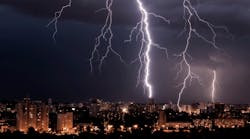Natural disasters can seriously disrupt manufacturing operations. If your plant (or critical supplier) is crippled for weeks or months, your revenue, reputation and shareholder value could hang in the balance. If your competitors rebound more quickly than you do, they may gain a competitive advantage.
It’s not enough to have insurance to cover your losses because it may never make your business completely whole again. That’s why it is important to take steps to prevent loss in the first place.
Here are seven actions manufacturers should take to minimize the effect of a major storm, quake or fire on their operations:
1. Be transparent with your insurer about your property risks. If your insurer has engineers who can scour your buildings, grounds and equipment for vulnerabilities, let them do it. You may not realize you’re in a flood plain, on a fault line, or under a roof that could be damaged by a hurricane. Your insurer may be able to provide you with detailed recommendations to shore up weak spots rather than using actuarial tables to calculate your premium without analyzing your potential risks.
2. Understand your business risk. Prioritize upgrades based on which of your properties are most important to your profit. You might find that the most valuable location isn’t always the most obvious one. For example, we analyzed a major manufacturer’s global organization and determined that a proprietary rubber gasket deep inside its product was the linchpin of its revenue. If the plant that made the gasket was ever decommissioned, it would take months to resume production in a new location. That plant needed protection first.
3. Plan well in advance. Have a solid written plan that addresses how you’ll protect property and business continuity when a natural disaster unfolds. For example, when a hurricane is developing, you’ll want to be prepared for strong winds by bringing moveable objects inside, securing what you can’t bring indoors, checking the roof for loose equipment, clearing roof drains and alerting partners who have already agreed to handle your capacity if your business is impaired.
4. Equip yourself. When a disaster strikes, you’ll also need gear. For example, if your factory is in a flood zone, you should have temporary water barriers available. These barriers are generally set up just prior to a flood and are generally taken down immediately after the threat has passed. They come in a variety of forms—from stackable wall panels to large interlocking water-filled bladders designed to divert floodwaters. In addition, secure backup power supplies (i.e., generators), satellite phones and holding tanks to manage wastewater if the municipal system is crippled.
5. Practice. When you’ve completed your plan and acquired your gear, practice executing the plan both on the tabletop and on the ground. Our experience indicates that preparation pays off. Facilities with a well-organized flood emergency response plan sustain nearly 70% less damage, and resume operations sooner, than locations without an adequate plan in place. Preparation could ultimately be a competitive advantage.
6. Get paid. If you’ve suffered a loss, promptly take pictures after the danger has passed. Keep logs, organize estimates and save receipts so that your insurer can start cutting checks. Some claims adjusters can pull strings to expedite orders of critical industrial equipment such as turbines or transformers. Your insurer can assist you until you’re back to normal.
7. Watch for aftereffects. Losses still can become worse after a storm has passed. Just as an aftershock can follow an earthquake, sunshine after a hurricane doesn’t mean you’re out of the woods just yet. In many cases, flooding related to a storm can be delayed: Although the wind and rain have subsided, bloated rivers may have yet to crest their banks and affect your community. Know whether you are in a flood zone and what the flood potential is. Once you have this knowledge, you should monitor the forecasts for future flood potential in your area.
The bottom line: natural disasters can cause lasting harm if you are not well-prepared. These tips should help you choose resilience over loss—even when your competitors don’t.
Katherine Klosowski is vice president and manager of natural hazards and structures at FM Global, one of the world’s largest commercial and industrial property insurers.
